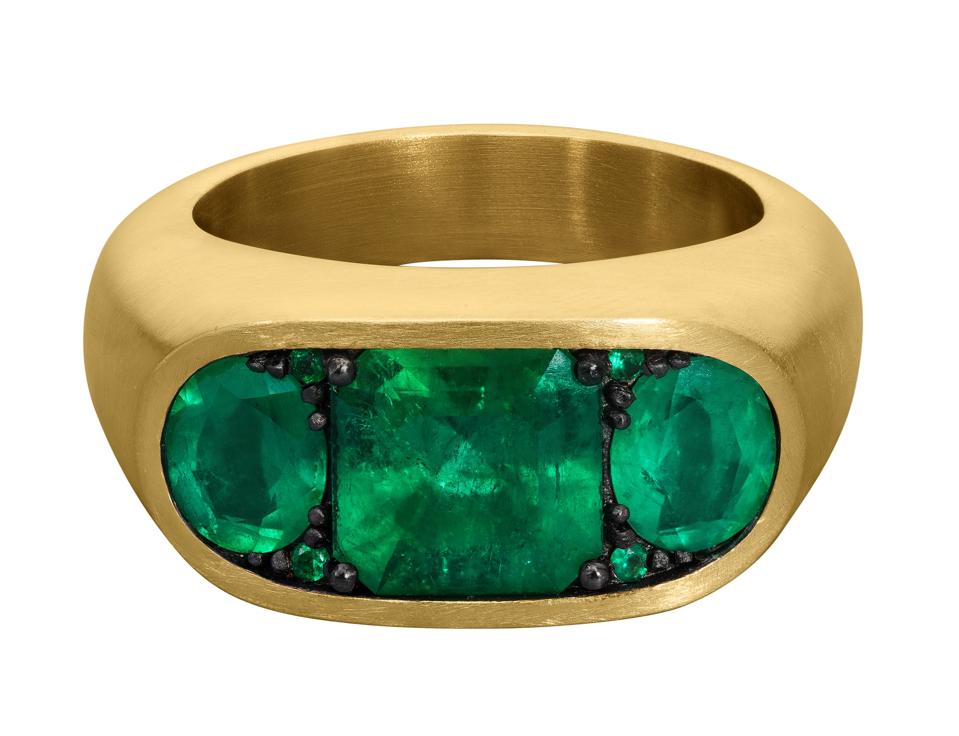Amongst antique Cartier diamonds and mid-century Jean Després bracelets, Shola Branson’s new collection shines out in the new exhibition space at Sotheby’s Paris. The Fragments collection, on show until April 12, not only highlights his fresh, chic aesthetic, it also showcases a modern approach to materials as well, through the exclusive use of SMO (Single Mine Origin) gold, responsibly sourced Colombian emeralds and Botswanamark diamonds.
It’s not the first time the British-Nigerian jewelry designer has shown with Sotheby’s. Branson was part of the cohort of Black designers who took part in the two Brilliant & Black exhibitions in New York and London, but his first show in Paris feels like an affirmation as well as an opportunity. “As my work matures and I continue to shape my place in the industry, presenting at Sotheby’s Paris feels like a significant milestone,” he says. “Paris is synonymous with luxury and a gateway to a global network of collectors.”
Despite the glitter of sizeable gemstones, the satiny gold and gentle geometry of the cartouche shape create the collection’s minimalist feel. Branson, who cites sci-fi, architecture, interiors, sculpture and pottery as inspirations, spends “a lot of time in museums looking at Ancient artefacts.”
In Fragments, his inspirations combine in futuristic-feeling forms, gems set into blackened gold to create meteorite-esque texture and diamonds with supernatural sparkle that can be traced back to a single Botswanan mine. The brushed gold of their settings, comes courtesy of SMO gold, an innovative British gold sourcing company that also provides traceability to the mine, representing Branson’s “commitment to sourcing materials responsibly.”
After becoming aware of the opacity of the gold supply chain thanks in part to documentaries like Gold Mafia (Al-Jazeera), he worked with SMO to choose the Sabodala-Massawa mine in Senegal, which has made biodiversity a “cornerstone of its operations” according to the SMO CEO, Charlie Betts. “The lack of traceability is an issue that more people are waking up to,” explains Branson. “Phrases like ‘recycled gold’ are often no more than green-washing, so as a creator I want to partner with suppliers that support independently audited, safe and responsible mining practices. This feels like a step in the right direction.”
For SMO, which works regularly with jewelry brands ranging from manufacturers to makers and lists brands like Boodles, Messika, Fernando Jorge and Emily P. Wheeler as partners, it’s a case of the more, the merrier. “We are thrilled to be working with Shola Branson on his first full collection,” continues Betts. “More than ever, emerging designers are placing greater importance on the origins and traceability of their materials. Sotheby’s has long been a defining force in the jewellery industry, and we are excited that they will be showcasing Shola’s SMO collection, bringing the significance of provenance to a wider audience.”
SMO was launched in 2017 by Betts and his brother, Dan, as a joint venture between their two companies; Betts Group, a British refiner and bullion dealer with over 265 years of history, and Hummingbird Resources, a gold production and development company. The brothers are aiming to raise the bar industry-wide on traceable, responsible gold sourcing, by working with three responsible mines in Africa: Yanfolila in Mali, Ity in Côte d’Ivoire and Sabodala-Massawa. The gold is then refined in Switzerland, in segregation — which pushes the prices up by 2-3% versus non-SMO gold — before being supplied to jewelers as grain or pre-made parts.
After building a solid foundation supplying over 2,000 jewelry producers in the UK and Europe, SMO is now expanding into the US, with Rhode Island-based C&J Fine Jewelry Makers as the exclusive distributor in North America. As they gain traction in this market, the hope is that SMO gold could reach a tipping point in the not-too-distant future.
Back in Sotheby’s showroom, the future is also top of mind, and not only for the futuristic forms of the collection. Fragments explores “time and technology,” and I’m interested to hear Branson’s thoughts on how tech is impacting his craft. For a designer who makes use of the possibilities afforded by new technologies while also upholding traditional jewelry skills for preservation, “it feels like we are experiencing a degradation of practical skills, as more contemporary makers — including myself — pursue the role of ‘designer’. [Yet] the progress of technology [hasn’t always been] linear; you see golden ages of mind-bending precision followed by periods of more rudimentary craftsmanship. I find this ebb and flow inspiring and interesting.”
Sotheby’s Vice Chairman of Jewelry, Frank Everett, has followed Branson’s career since the early days, drawn to his original approach to design “which is both fresh and modern. As a self-taught artisan, Shola consistently brings an element of surprise to his creations, especially in the way he uses coloured diamonds. I also love the unique, warm finish he achieves on the 18K gold pieces.” “I’m proud to contribute to the evolving landscape of jewellery,” finishes Branson. “This collaboration with Sotheby’s is a step forward in my creative journey.” And for the collectors visiting the collection in Paris, Fragments begs the question: why are more luxury jewelry brands — especially those with the financial flexibility — not making use of single-origin materials?





